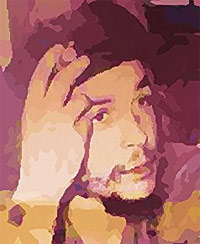 |
 |
 |
 Travel & Outdoors | The Cuba Connection | March 2005 Travel & Outdoors | The Cuba Connection | March 2005  
The Real Tragedy of Che
 Peter G. Chronis - Denver Post Peter G. Chronis - Denver Post


| Guevara's famous portrait in beard and beret is now printed on T-shirts worn by youngsters in both hemispheres who may little realize what a stone killer the hero of "The Motorcycle Diaries" was.

|
Put the word "motorcycle" in the title of a film, even a '60s-vintage, Grade B biker flick, and I'll watch just to ogle the "iron."

My favorite scene in "Lawrence of Arabia" is at the beginning, when the hero of the Arab uprising against the Ottoman Turks is shown astride a Brough Superior V-twin, the Holy Grail of classic British motorcycles.

So why did it take so long for me to see "The Motorcycle Diaries"? Politics. I never had any use for Ernesto "Che" Guevara de la Serna, the Argentine-born hero of the Cuban Revolution, when he was alive. Nor for his buddy, Cuban dictator Fidel Castro. Nor Communists in general.

"The Motorcycle Diaries" takes its title from Guevara's book about an 8,000-mile (mostly) motorcycle odyssey on a 500cc 1939 Norton that Guevara (played by Gael Garcia Bernal) and his pal, Alberto Granado (played by Rodrigo de la Serna), took through South America. Guevara at the time was a medical student nicknamed "Fuser," and Granado was a biochemist, although the often-penniless pair passed themselves off as doctors.

The smoke-belching motorcycle called "The Mighty One" sorely needed a ring job, but it was a classy machine nonetheless. Sadly, it was sacrificed for the film.

Guevara and Granado (in search of adventure and sex) leave Buenos Aires on Jan. 4, 1952, heading south to Patagonia and crossing into Chile and before turning north.

Most roads are unpaved, and they take several spills. Finally, the Norton refuses to run, and they talk a local mechanic into repairing it. But the brakes fail just as a herd of cattle pops up on the road. This final crash turns "The Mighty One" into scrap metal. The pals continue on foot and by thumb into Peru and part company when the journey ends in Venezuela on July 26, 1952.

En route, they encounter the poor, the dispossessed, the downtrodden, as road movie morphs into a Marxist indictment of the very real class divides in Latin America.

The film Guevara is a compassionate human being who treats the sick as best he can. Near the end of the film, Granado and Guevara spend three weeks caring for patients at the San Pablo leper colony in Peru.

On his birthday, the asthmatic Guevara does a replay of Chairman Mao (who heroically swam the Yangtze) by heroically swimming the Amazon River that divides the leper colony. In a treacly tableau with all the finesse of a Stalinist propaganda film, the lepers cheer him on from one side of the river, while Alberto and the hospital staff fret on the other.

This feat inspired the film's Academy Award-winning song, "Al Otro Lado del Rio" ("On the Other Side of the River").

The movie left me wondering how the idealistic healer (who got his medical degree in 1953) became the merciless commandante who sent scores to the firing squads in Cuba. Guevara had gone to Mexico in 1954, where he met Castro. He followed Castro to Cuba as a medical officer. They arrived on July 26, 1956, to launch the revolution to overthrow Fulgencio Batista, the military strongman who had ruled Cuba with an iron fist since the 1930s. Guevara became a skilled guerrilla fighter and Castro's top lieutenant.

Batista's regime collapsed in January 1959, and Guevara held several official positions. But Che had become a loose cannon, stuck in the revolutionary mode. Castro had other priorities. In October 1967, Guevara was captured and executed by Bolivian troops while trying to foment a popular uprising. (The epilogue to "Diaries" says the CIA ordered his murder.)

Granado eventually settled in Cuba, where he started a medical school.

Guevara's famous portrait in beard and beret is now printed on T-shirts worn by youngsters in both hemispheres who may little realize what a stone killer the hero of "The Motorcycle Diaries" was. That may be the real tragedy of Che Guevara's life.

And Cuba? It's still ruled with an iron fist by a dictator, 46 years after its "liberation." | 
 | |
 |



